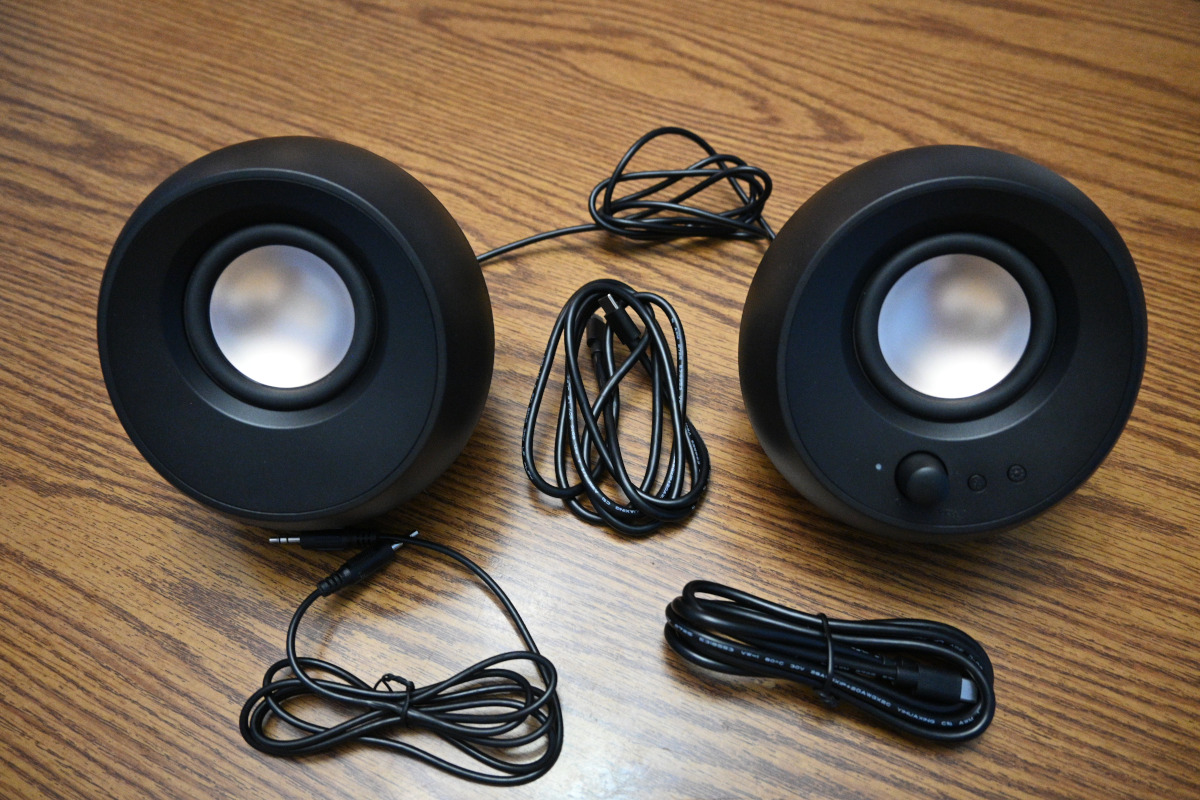Search
[{{{type}}}] {{{reason}}}
{{/data.error.root_cause}}{{{_source.title}}} {{#_source.showPrice}} {{{_source.displayPrice}}} {{/_source.showPrice}}
{{#_source.showLink}} {{/_source.showLink}} {{#_source.showDate}}{{{_source.displayDate}}}
{{/_source.showDate}}{{{_source.description}}}
{{#_source.additionalInfo}}{{#_source.additionalFields}} {{#title}} {{{label}}}: {{{title}}} {{/title}} {{/_source.additionalFields}}
{{/_source.additionalInfo}}- Details
- Category: Hardware
- By Jason Gress
- Hits: 827
Creative Pebble X

Creative Pebble X
Specifications:
2.0 USB-C Computer Speakers with RGB lighting
2.75" full-range drivers
Passive radiators
15W RMS, 30W Peak
When connected to USB-PD Power Adapter:
30W RMS, 60W Peak
Frequency Response: 60-20,000Hz
Connectivity in: 2x USB-C, 3.5mm AUX, Bluetooth 5.4 in
Connectivity out: 1x 3.5mm 4-pole stereo headset, 1x 3.5mm microphone in port
Supports Windows PC, Mac OS, PS4, PS5, Android, iOS, other via 3.5mm or Bluetooth
Powered by USB-C 5V 3A connection with optional USB PD input for 15V 2A
Includes 2x 1.5m USB-C to USB-C Cable, 1x 3.5mm AUX input cable
3.94 foot cable between Left and Right speaker
Dimensions: 5.49" x 5.2" x 5.35" each for Left and Right speaker
MSRP: $89.99
(Amazon Affiliate Link)
Thank you Creative Labs for sending us this Creative Pebble X to review!
I've long been an admirer of Creative Labs for many years, starting with my Sound Blaster 16 sound card way back in the heyday of early PC gaming. What's fascinating is how different of a company they are from those days. Back then, every PC had to have a sound card, and Creative Labs was the biggest, and certainly one of the best. Nowadays every computer has onboard sound, so they instead focus on speakers, USB sound cards, headphones, and other audio products. We've reviewed a couple of their sound bars up to this point, and they're pretty good, but these Pebble speakers surprised me. They are a simple yet brilliant design, that sounds way better than I expected.
Creative's original Pebble design was, from what I can tell via online search, released sometime around late 2017. Apparently it made quite a splash, because these have been a top seller for them. By pure luck and chance, a good friend of mine happened to have a set or the originals, and he brought them over; I was very impressed. There isn't a lot of bass, but the sound is remarkably clear and reasonably balanced, especially for the insanely low price of $25. They also happen to look really nice, and get unexpectedly loud.
Having high hopes for these much larger sequels, we were blessed to be able to check out the Pebble X with a review sample. They are sharp looking, and feel heavier and higher-quality than I expected, despite coming in a small box. Each is a spherical speaker made entirely of plastic, with three flat slices of sorts cut out of the sphere. The front is of course the 2.75" speaker driver, angled up and towards the listener. On the rear opposite that is the flat passive radiator, used to help extend the bass response. On the bottom of the sphere is the flat base, where you place it on your table. There is a rubber grip on the bottom, and a threaded inset for putting them on stands if you wish.
By intention or coincidence, circles or spheres happen to have some advantages when it comes to speaker shape, because it helps minimize baffle step diffraction, reflections, and resonances. By pointing the drivers up towards a typical desktop listener with a 45 degree angle, the drivers point right to your ears. You almost always get the most fidelity out of speakers pointing them at your ears, which is one reason why sound bars tend to sound muffled in comparison to separate speakers most of the time.
As a matter of fact, I compared these Pebble X's directly with the Sound Blaster Katana SE I reviewed last year and for desktop use, I would probably prefer the Pebble X. It's not that the Katana isn't better in many ways, it is, but one major benefit of separate speakers compared to sound bars is not only fidelity, but what is called soundstage. It's basically the 3D image of sound in a field of space virtually in front of the listener. The soundstage of these speakers is remarkably good for something so small and relatively inexpensive.
Strong Points: Good value; great connectivity options; well-balanced sound with nice imaging; gets quite loud, especially with second power source connected; looks really sharp; headphone out works great; customizable sound via Creative PC app
Weak Points: Connectivity between speakers can't be lengthened; midrange-focused sound; lack of USB-A adapter
The sound signature in general of this Pebble X is midrange focused in my opinion, while the sound of the older Pebble emphasized treble and detail a bit more. There is some bass, which the passive radiators on the small 2.75" drivers on this Pebble X help bring out. It's really not all bad, but there isn't deep bass to speak of, which is what it is - you can't defy the laws of physics. With that said, in Windows there is the Creative app, and you can counteract the default midrange-centric profile a bit using that - at least using the USB-C input source on PC.
What I do is start the Creative App, select the Pebble X, then click on 'Acoustic Engine'. Then, select 'Bass', and leave the default amount of boost at '50', though you can adjust it as you see fit. I also found that a small amount (25 or less) of the 'Crystalizer' effect to be desirable, but this is entirely to taste. I like a slight 'V' shaped EQ, but only a little bit. It really depends on the music. You can also apply a 10-band equalizer if you like instead of or along with the Creative Acoustic Engine, though I would personally choose one or the other to tune the sound to your preferences. Along with features like 'Bass' and 'Crystalizer', there are others like 'Surround', 'Smart Volume', and 'Dialog+'. Surround tries to enhance the soundstage, which I did not feel was needed, since these really sound plenty wide if placed properly on your desk. Smart Volume applies compression to make the difference between quiet and loud less drastic, and Dialog+ makes vocals louder. I find these features to be largely unnecessary and situational, but if you would rather use speakers than headphones late at night, they might help.
Speaking of headphones, there is a competent headphone jack on the side of the right speaker. Unfortunately, any Acoustic Engine effects applied to the speakers also impact the headphone jack, which is a shame. On the right speaker is where all of the controls are, with the volume knob, source selector button, and RGB lighting button. On the far right side is that headphone jack, along with a 3.5mm jack for a microphone as well. You can certainly use a wired gaming headset with a mic with those if you wish. I will say that in most cases the onboard sound might be preferred since the EQ and Acoustic Engine settings apply to your headphones also, but that is up to you.
On the rear of the right speaker is of course the passive radiator, as both sides have one, but underneath all of that are the main inputs for audio sources. There is an AUX port for a 3.5mm audio in jack, which works great as an input for the speakers. I will say that the cable that comes with the Pebble X is rather basic but gets the job done. It looks like ones I used to buy at Radio Shack back in the day. Next to that are two USB-C ports, one labeled just USB-C, and the other labeled USB-C PD. This second port is for additional power, and using this is strongly recommended, as the speaker really comes alive.

You see, this speaker supports connecting a USB-C Power Delivery (PD) adapter to that port, where the speaker can request an additional 15V 2A power draw from that additional adapter. By default, the main USB-C port that can send 5V 3A max, along with audio data via the USB-C cable. This maxes out at 15W, and it sounds fine, but the bass is mostly gone and it doesn't get all that loud. A reasonable listening volume to be sure, but when you plug in that second plug into a USB-C PD adapter, man do these things wake up. Not only do these speakers get a lot louder, but the bass comes alive as well with a lot more thump. You're never going to get really deep bass out of tiny drivers like these, but it still helps a whole lot. I highly recommend using a second power adapter on these speakers if at all possible. I happen to have one at my desk already because I like to charge things like my phone, Nintendo Switch or Steam Deck while I'm sitting here, so I had a PD-compatible charger already handy.
On top of the two very good wired connectivity options, there is also Bluetooth 5.4 connectivity. I paired it up with my phone, and it works great. It only supports the SBC audio CODEC, and the USB-C connection only supports 16bit @ 48kHz sample rate, which is probably just fine for a simple desktop speaker like this. They sound quite good for desktop speakers, but they don't resolve like 'real' bookshelf speakers do. But they also cost a fraction of what those do. And they take up a much smaller space on your desk, too. Though I should probably point out that the speakers come with two USB-C cables, but no USB-A adapters. I had to supply my own to connect them to my desktop PC, since I didn't have any USB-C ports handy. Most laptops are coming with more and more USB-C ports, and desktops are getting there, but not quite yet.
The final cable out of the right speaker is built-in, and connects to the left speaker. Pretty simple, but since it's not removable or pluggable in any way, it's worth noting that you can't separate the two speakers more than about four feet. It's a shame, because on the bottom of each speaker is a threaded inset that look like they would work for microphone stands. I really like that they offer this, but with only a four-foot cord between them, it really limits how far apart those stands can be, making that feature hard to use. It's a notable oversight in an otherwise overperforming speaker.
Being targeted for PC use, there is optional RGB lighting that glows along each side of the speakers. You can adjust the brightness and colors, depends on your preferences. The effects are a 'Chasers', 'Aurora', 'Peak Meter', 'Glowing', 'Wave', 'Cycle', 'Static', or 'Morph'. Static is a single color, and Peak Meter dances to the music. The rest shift between colors in some pattern that I'm sure is different but I personally don't really care for constantly changing colors. You can of course turn the RGB off if you like. You can also adjust the brightness level.
Overall, I am pleasantly surprised with the Creative Pebble X desktop speakers. The USB + Bluetooth + 3.5mm connectivity options, the much better than I expected sound, and the great look on your desk make these a compelling option for many. I will say that I think the Pebble X Plus, which has the same base speakers with an additional subwoofer, might make for a better-sounding setup, but they do cost more. The soundstage these things put out tells me that at least for some gamers, they might be a great option for desktop speakers if space, budget, and loudness tolerance is limited. Just be sure to get that second power adapter to help make these things really sing!




